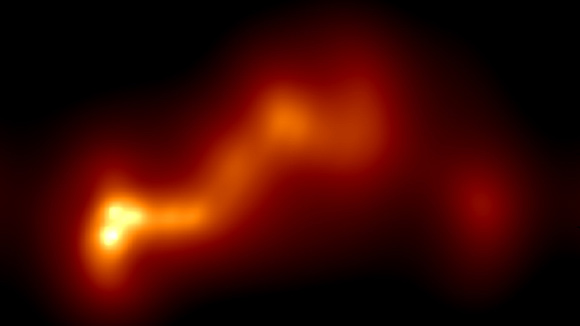Using data from the 10-m space radio telescope RadioAstron and a network of 27 ground-based observatories, astronomers have detected an unusual ribbon-like jet at the core of OJ 287, a galaxy located about 5 billion light-years away in the constellation of Cancer.
This image of OJ 287 reveals the sharply curved, ribbon-like structure of the plasma jet emitted from its center. Image credit: Efthalia Traianou / Heidelberg University / IWR.
“Among the various classes of active galactic nuclei, BL Lacertae (BL Lac) objects stand out for their rapid, large-amplitude variability and significant polarization across multiple wavebands, which is attributed to relativistic jets aligned closely with our line of sight,” said Heidelberg University astronomer Efthalia Traianou and colleagues.
“A prominent member of this subclass is OJ 287, situated at a redshift of z = 0.306.”
Optical observations of OJ 287 extend back to the 1880s, resulting in an exceptionally long light curve spanning nearly 150 years.
This extensive dataset revealed periodic brightness fluctuations, including a prominent 60-year cycle and recurrent, doubly peaked high-luminosity flares approximately every 12 years.
These periodic variations are explained well by the presence of a supermassive black hole binary in which a secondary supermassive black hole follows a precessing, eccentric orbit around a more massive primary.
“We have never before observed a structure in the OJ 287 galaxy at the level of detail seen in the new image,” Dr. Traianou said.
“The image, which penetrates deep into the galaxy’s center, reveals the sharply curved, ribbon-like structure of the jet.”
“It also points to new insights into the composition and the behavior of the plasma jet.”
“Some regions exceed temperatures of 10 trillion Kelvin — evidence of extreme energy and movement being released in close proximity to a black hole.”
The astronomers also observed the formation, spread, and collision of a new shock wave along the jet and attribute it to an energy in the trillion-electron volt range from an unusual gamma ray measurement taken in 2017.
They captured an image of OJ 287 in the radio range using RadioAstron and 27 ground-based observatories.
The image is based on a method of measurement that takes advantage of the wave nature of light and the associated overlapping waves.
“The interferometric image underpins the assumption that a binary supermassive black hole is located inside OJ 287,” the researchers said.
“It also provides important information on how the movements of such black holes influence the form and orientation of the plasma jets emitted.”
“Its special properties make the galaxy an ideal candidate for further research into merging black holes and the associated gravitational waves.”
The findings appear in the journal Astronomy & Astrophysics.
_____
E. Traianou et al. 2025. Revealing a ribbon-like jet in OJ 287 with RadioAstron. A&A 700, A16; doi: 10.1051/0004-6361/202554929
